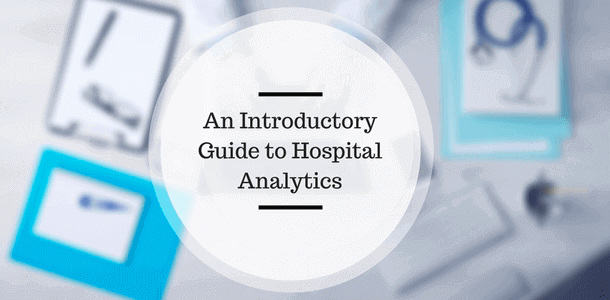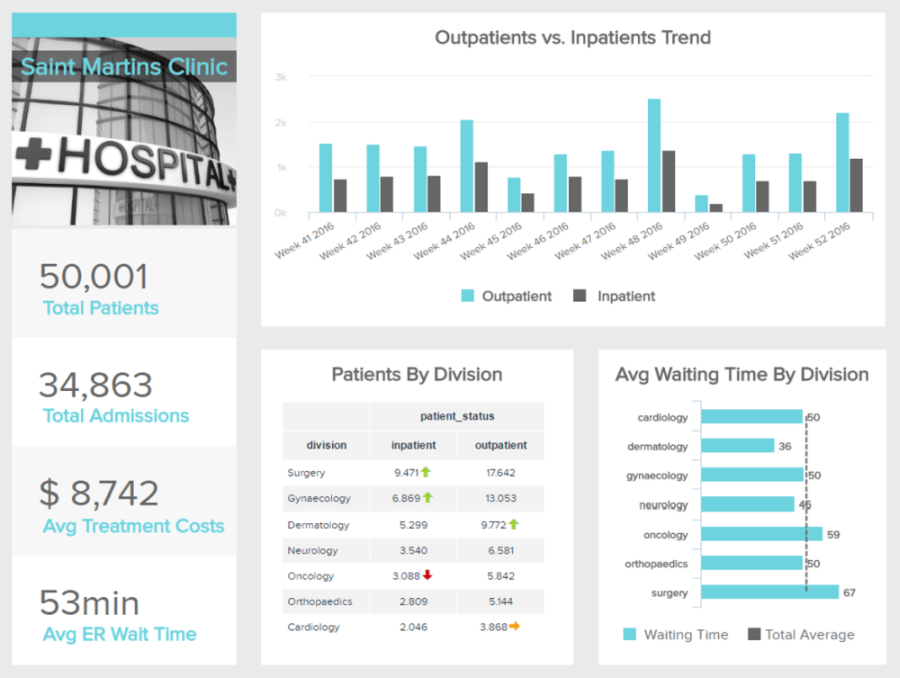An Introductory Guide to Hospital Analytics

“It is a capital mistake to theorize before one has data.” Sherlock Holmes
The rise of data analytics has majorly changed the way we see the world. We no longer need to shoot in the dark to make informed decisions. The modern world comes available with a wealth of data, the kind that offers deeper insights than we could have possibly imagined even a decade ago. In fact, six million developers across the world are currently working on big data and advanced analytics. What’s more, by 2020, 1.7 megabytes of data will be created each second, for every person on earth.
Now, one of the fields that stands to benefit greatly from the adoption of data analytics is the healthcare sector - and we're talking about hospitals in particular. Not only can the smart use of data make hospitals run more economically and efficiently, but it can also aid patient care and save lives. Before we delve any deeper, let’s consider something for a moment.
Explore our 14-days free trial and get the most out of your hospital data!
What Does Hospital Analytics Mean?
A branch of business intelligence in healthcare, hospital analytics is a term for analytical activities that are undertaken as a result of data collected from the following four primary areas within the healthcare sector:
- Claims and cost data
- Data relating to pharmaceutical and research and development
- Clinical data collected from ongoing patient care, Electronic Healthcare Records (EHRs), and trials
- Key patient behavior and sentiment data
While healthcare covers a broad spectrum, hospitals are perhaps the most important of all due to their high capacity and high functioning nature. And also, whichever way you look at it, these medical institutions handle life or death situations every single day.
If hospitals use healthcare analytics software to make every element of their day to day running more predictive, more intuitive, and more efficient, the benefits will be endless.
Let's look at some of the ways that medical institutions can use these metrics to their advantage.
How Hospital Analytics Can Be Used For Significant Enhancements
The bottom line is this: these metrics can serve to reduce costs and improve care coordination. More specifically, here's how the intelligent use of acquired data can seriously improve the level of service hospitals can provide:
Cutting down administrative costs
Speaking to Healthcare IT News on the subject, George Zachariah, a consultant at Dynamics Research Corporation in Andover, Mass., explains that reducing the administrative costs is really one of the biggest challenges in the industry. Indeed, "one-fourth of all healthcare budget expenses are going to administrative costs, and that is not a surprise because you need human resources to perform." By gathering and studying metrics relating to daily hospital spending in all areas from catering right through to pharmaceuticals, data analysts can help overstretched medical institutions streamline budgeting processes and make cuts or substitutions that are safe as well as ethical.
Quashing fraudulent behaviour
By tracking fraudulent payments, in addition to the history of individual patients, it will be possible to cut down on wasted time and money on dealing with these kinds of situations. But, to do so effectively, it’s essential to not only implement the right analytics tool but gain a deeper understanding of how it works to achieve the best possible solution.
Enhanced care coordination
Often hospital systems and IT infrastructures can be incredibly disjointed, leading to delays, inefficiencies, and mistakes that can, in turn, prove detrimental to the patients. By using targeted metrics and insights to spot holes within the internal infrastructure and help make these systems more open, more fluent, and more communicative to ensure medical records, patient data, and any other critical information is shared both swiftly and accurately. With the right analysis and the right development, this approach can ensure that hospitals and medical institutions across the country - or even the world - can share vital patient information.
Improved patient wellness
Hospital data analytics can assist hospitals in providing information on an individual patient level, based on how they can maintain a healthy lifestyle tailored to their medical history and biometric stats. Not only is this a valuable form of patient aftercare, but it's also a critical measure towards helping prevent the number of people that end up back in the hospital.
Hospital predictive analytics
By understanding and acting upon both historical and real-time insights, hospital predictive analytics has the potential to help make improvements in all key areas before issues unfold and help spot potentially fatal medical issues in patients before they occur. Along with big data in healthcare, this is perhaps one of the most powerful use of hospital data analytics available to us at present.
Hospital Analytics Metrics You Can Use
When it comes to valuable hospitality analytics, there are a number of metrics or KPIs (Key Performance Indicators) that can help enhance the overall efficiency of a medical institution. For a full and comprehensive rundown of these priceless metrics, you can have a look at our complete article on business intelligence in healthcare.
To give you more insight into the data in action, here is a glimpse at two of our main KPI-based dashboards:
Hospital KPI dashboard
**click to enlarge**
Main KPIs utilized:
- Treatment costs: A monetary management KPI that helps calculate the amount of money a patient costs to the hospital.
- ER wait time: Emergency room wait time measures the amount of time from when a patient arrives at the ER to when they physically see a physician. This metric should be monitored closely over time to spot trends and iron out any unusual spikes in wait time.
- Patient wait time: The period of time the patient has to wait for treatment or consultancy is the biggest factor in patient contentment. This KPI measures the average length of time patients have to wait from registration to treatment. Of course, the lower the wait time, the better.
Overview:
As you may have gathered, in healthcare there is a great deal of data to collect, quantify and arrange, and when it comes from a host of different departments, some insights get lost in the mix, remaining untapped.
This centralized hospital dashboard aides the efficient management of your institution by helping you to identify emerging trends over time, allowing you to adapt how you conduct key tasks and assign your resources.
The hospital dashboard offers a digestible view of the big picture, the kind of which you need when trying to run such a complicated institution in a safe, secure and successful fashion.
The particular example above is geared toward offering an organic view of essential data with global insights on how the facility is functioning. This dashboard is aimed at helping top-level executives and managers make the most informed decisions possible - and as you can see, some of the KPIs mentioned feature here.
Explore our 14-days free trial and get the most out of your hospital data!
Hospital Performance Dashboard
**click to enlarge**
Main KPIs utilized:
- Average hospital stay: A general measurement of the time spent, on average, by a patient admitted in a hospital.
- Hospital readmission rates: The Hospital readmission rate shows the number of patients that return to the hospital within a short period after being released. This particular KPI offers an excellent insight into the level of care that has been offered and how it can be improved.
- Costs by payer: A metric that will evaluate the distribution of the costs among the various organisms, costs by payer assessment of the healthcare providers that are covering the care of your patients. By understanding this, you can also gain a solid insight into overall patient satisfaction.
Overview:
The hospital performance dashboard leverages the aforementioned Average Hospital Stay, Hospital Readmission Rates and Cost By Payer KPIs to define targets and provide an insight into desired outcomes all in one easy-to-navigate space.
Working with dashboards like this will help you enhance your efforts on a clinical level as well as an operational and financial level. Plus, these particular metrics will help you understand which actions to take should the institution be underperforming in certain areas, which as we know, can in some cases mean life or death.
To find out more about our bespoke hospital dashboards, look at our healthcare dashboard templates.
Quickfire case study: medical institutions benefiting from hospital analytics
You know what they say: the proof is in the pudding.
That said, here are three shining examples of modern medical institutions benefiting from healthcare and hospital data analytics, according to a study from Healthcare Data Management Magazine.
University of Pittsburgh Medical Center and Cancer Research
One of the leading medical institutions in the US, the University of Pittsburgh Medical Center has found new ways to gather, assimilate, and analyse separate data feeds that were once difficult to access and consolidate. These efforts are significantly enhancing the institute's cancer research efforts.
ICU Care and Predictive Analysis
This renowned medical institution, in recent years, began pushing live data feeds into a custom-built application that offers profound insights into patient risk levels in its intensive care units, helping to prevent potential issues and understand how to make vital improvements.
Advocate Health and Quality of Care
In collaboration with Cerner, Advocate Health developed analytical tools in 2015, the kind of which that hosted on the vendor's cloud-based population-health management software platform to improve its level of patient care, as well as its hereditary cancer testing service.
Explore our 14-days free trial and get the most out of your hospital data!
Data: The Future of Healthcare
Data has the power to change the world - and it's already doing so as we speak. By gathering data from various sources, understanding healthcare-based KPIs, and using these findings to make vital improvements across the organization, your hospital has the potential to be 100% more effective, improving the lives of your staff as well as your patients exponentially. And that is absolutely essential.
To find out more about how a BI software can help your institution, you can easily start a 14-day free trial, or get in touch with us - we look forward to hearing from you.

